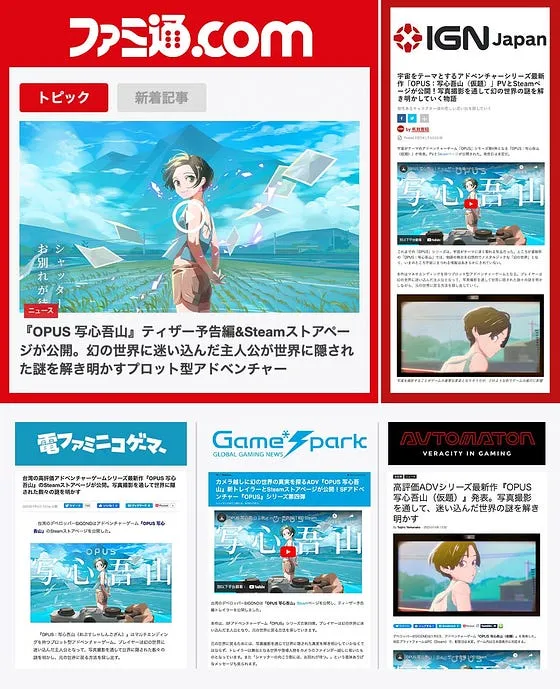
Hi, I’m Sissi, the marketing manager at SIGONO, the studio behind OPUS: Echo of Starsong. While there’s no shortage of advice on pitching to Western media, insight into working with Japanese media remains scarce. Media exposure is crucial for games venturing into overseas markets, and Japan’s gaming industry is no exception. With many Japanese media organizations boasting thriving Twitter communities, getting published by them opens the door to millions of gamers on Twitter — an opportunity no savvy marketer should miss!
However, the insular nature of Japanese society makes proper localization and a deep understanding of their customs essential. In this article, I’ll share a comprehensive account of our media outreach efforts, detailing how we tailored engaging marketing materials that resonated with the Japanese market. I’ll also highlight what I think we did right from a marketer’s perspective, using OPUS: Prism Peak as a case study. So buckle up and let’s dive into the fascinating world of Japanese media outreach! I hope you find it helpful!
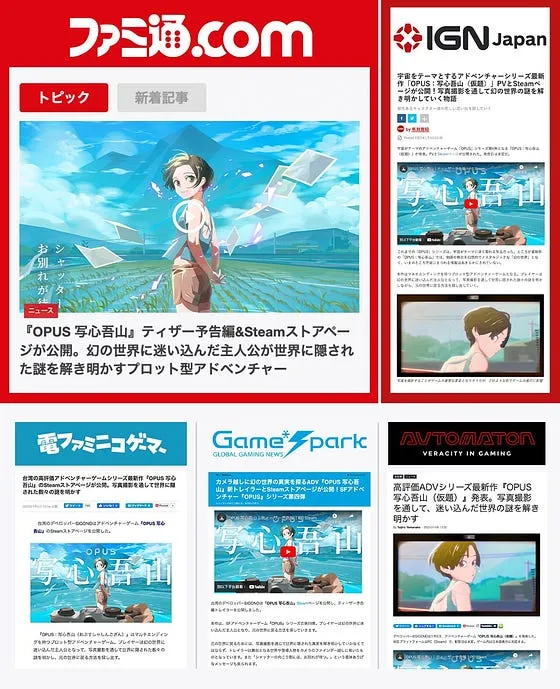
Diverse Japanese media coverage of OPUS: Prism Peak
Successful media outreach is all about the details, but before we dive into the nitty-gritty, let’s discuss a basic principle for approaching the media:
You must drive traffic to the media.
Think from their perspective, and communicate in their language.
With that in mind, let’s explore the primary materials, supplementary materials, and key considerations for effective Japanese media outreach:
Primary Material 1: Image Assets
Image asset creation is all about one thing: driving traffic to media. All commercial media, regardless of location, share the common goal of increasing views, clicks and engagement on their platforms and within their communities.
So how do we help drive traffic to media? By providing materials that will pique the interest of their readers — otherwise known as traffic-generating assets. When pitching to media, make sure the materials you provide meet both of these criteria for media sites and communities:
Ease of Use:
Familiarize yourself with common image requirements for major media outlets and deliver material that doesn’t require cropping, is easy for journalists to use, and shows the full impact of the image.
Attention-grabbing:
Keep your team motivated by celebrating their artistic talents and maintaining a positive attitude. Before launching your marketing efforts, create mockups of your artist’s images on the target outlets to gauge their attention-grabbing potential. If they don’t quite hit the mark, go back to the artist with your mockup and ask for help.
The definitions of “ease of use” and “attention-grabbing” may vary depending on the country and media you’re targeting, so do your research before pitching!
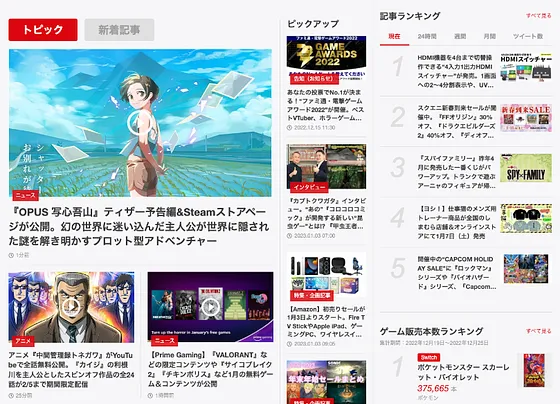
caption: Stunning Feature Art for OPUS: Prism Peak, ready for journalist use!
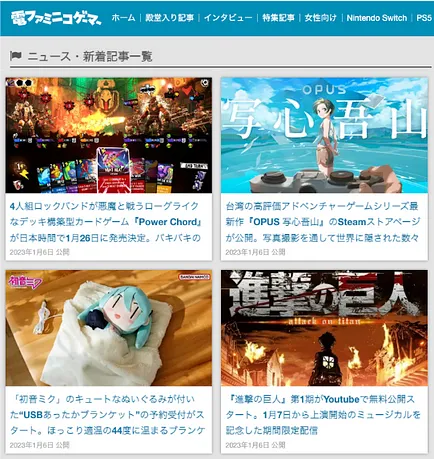
In my emails to media contacts, I typically attach the following two types of image assets:
Static Assets:
Feature art — Deliver in both vertical (1417 x 1984, < 1MB) and horizontal (1920 x 1080, < 1MB) formats. Due to the variety of media layouts, providing both orientations gives media the flexibility to utilize them, ensuring that the full appeal of the visual assets is showcased.
Animated Assets:
GIF (< 1MB) — With many Japanese media outlets having a strong Twitter presence, creating engaging animated images is key, as Twitter users love GIFs. Creating a compelling GIF can help you tap into this huge audience. For example, one of our GIFs received 380K views from a single post on Denfaminicogamer (電ファミニコゲーマー). Achieving similar reach through paid advertising would require a substantial budget, making GIFs a cost-effective marketing strategy.

So, start creating eye-catching static and animated image assets that resonate with Japanese media and gamers, and watch your outreach efforts soar!
For tips on how to make a great GIF, I recommend this classic talk by fellow PR expert Thomas Reisenegger:
Once you’ve created your marketing materials, there are two critical tasks you need to complete to ensure your assets are well-prepared:
Optimize the file size:
Keep in mind that many journalists prefer to check email on their phones. Ideally, your entire email should be under 5MB to ensure that content is displayed immediately upon opening. Imagine if an email took over 5 seconds to load, surely you’d grow impatient and want to close it as well? Also, if a journalist is using an iPhone app to check email, GIFs larger than 1MB will require a click to view. Keep your GIFs under 1MB so they show up automatically.
Pay attention to file naming:
Before your email is opened, the attachment filename appears below the subject line in the recipient’s inbox. If the filename is too random, your email may look like spam or a commercial message. It’s best to use the filename to make the contents of the attachment clear. Although it’s often overlooked, the filename carries as much weight as the email subject and should never be underestimated.

By optimizing file sizes and naming conventions, you can create a polished and professional impression with your marketing materials, increasing the chances of capturing the attention of Japanese media.
Primary Material 2: Letter
When writing a letter to the Japanese media, your content should accomplish three goals:
-
Pique journalists’ interest
-
Convey game information accurately
-
Lower the barrier for journalists to cover the game
Be sure to include the following key points in your letter:
Elevator pitch
Craft a powerful sentence that highlights your game’s unique selling point. There are many resources on GDC Talks about creating an elevator pitch. Personally, I recommend these two videos:
In this talk, Mike Rose breaks down elevator pitches into the “Hook” and the “Kicker” and shares his thought process.
This video explores how “This War of Mine” found their positioning, appeal and created their elevator pitch.
Game Introduction
An eye-catching, accurate, and concise description of the game, about the length of a Steam description. Ideally, it should be written so that journalists can copy and paste it directly. We know journalists are busy. Making their lives easier, reducing their workload, and lowering the threshold for coverage can increase your game’s chances of being covered.
Endorsements
If your game lacks popularity or unique news angles, celebrity endorsements, awards, or attention in certain markets can give journalists more incentive to cover your game.
Japanese letter etiquette/format
When submitting to Japanese media, try to use a formal tone that is different from Western media. Below is the structure I often use:

caption: Masterfully illustrated by me!
You can easily find professional explanations for greetings, closings, cushion words (クッション言葉), you can easily find professional explanations through Google, so I won’t elaborate here.
As for the placement of the GIFs, I sometimes place them before or after the main content, and sometimes sprinkle them throughout, depending on the specific GIF content or current needs.
Signature
Japanese emails typically include the company name, signature, email, and address. My emails include the company name, signature, official company website, and one or two links to the company’s social media. Including your company’s official website shows professionalism, and including one or two social media links that are active in the Japanese market can demonstrate your company’s presence and popularity in Japan, increasing the recipient’s confidence in covering your game.
By crafting a compelling letter that addresses these key points, you can effectively engage with Japanese media and increase the chances of your game being noticed.
Primary Material 3: Trailer
When you receive a trailer for marketing purposes, your first task is to give it an appropriate name. Label them in media-speak to effectively say, “Hey, here’s something to cover. Derek Lieu’s “Game Trailer Types and When to Make Them” summarizes several common trailer types and their content:
-
Cinematic, Animated, or Live-Action Trailer
When pitching to Japanese media, be aware of the “Japanese-English” terms they often use. For example, use “PV” (Promotion Video) instead of “trailer” as it is more familiar to them. Other commonly used terms include ティーザー (teaser) for teaser trailers and 予告編(Trailer). Make sure you use the appropriate terminology to avoid confusion and help them understand the content of the trailer.
Also, optimize your YouTube video and thumbnail:
YouTube Video Description
Upload your video to YouTube and provide a media link for easy direct embedding by media outlets. Create an engaging YouTube video description, include a call-to-action (CTA), and add a link to your Steam page to direct viewers there.
YouTube Thumbnail
1280×720 (under 2MB) — Most Japanese media outlets prefer to embed YouTube videos directly, so the thumbnail is crucial in a media report. Approach its preparation with the same dedication as you would for feature art.
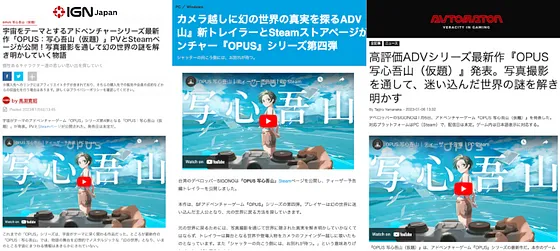
caption: The importance of a captivating YouTube video thumbnail
By tailoring your game trailers and thumbnails for the Japanese market, you can effectively engage with Japanese media and maximize the impact of your marketing efforts.
Supplementary Material 1: Japanese Game Page
Although not required, minimizing language barriers is always beneficial when entering foreign markets. If your game supports Japanese, remember to select the appropriate settings on your Steam page.
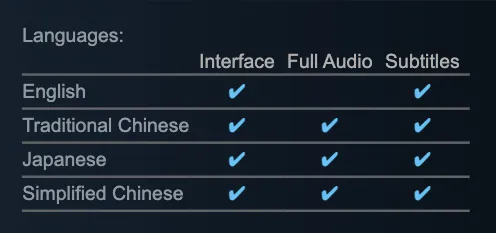
While Japanese journalists obviously prefer a game to support Japanese, from my experience this doesn’t necessarily influence their willingness to cover it.
A simple way to think about it is to break it down into 4 scenarios:
-
Game supports Japanese, Steam page also available in Japanese: Ideal
-
Game supports Japanese, Steam page unavailable in Japanese: Slightly disappointing
-
Game does not support Japanese, Steam page unavailable in Japanese: Let it be
-
Game does not support Japanese, Steam page unavailable in Japanese: Risky
In the fourth situation, ensure that the game page explicitly states in Japanese that the game doesn’t support the language to avoid misleading potential buyers and provoking dissatisfaction.
Supplementary Material 2: Japanese Press Kit
Media professionals receive hundreds of e-mails every day. Aim for concise communication and provide comprehensive game information in a Japanese press kit that complements the email. The email should generate interest in coverage, while the press kit provides complete game details. Interested journalists can explore the press kit on their own to find appropriate material to cover.
A press kit typically includes:
-
Factsheet (including developer, game page link, company website link, release date, platform, languages; for undecided items simply write TBA)
-
Any other information that may aid journalists in their reporting
In the case of SIGONO, our strength lies in the accumulated awards and recognitions for the OPUS series. Including this information in the press kit increases the media’s confidence in our work and persuades them to cover our new releases. I feel confident in its effect because time and again, I see articles that introduce the OPUS series as “multi-award winning” and “highly-rated”.
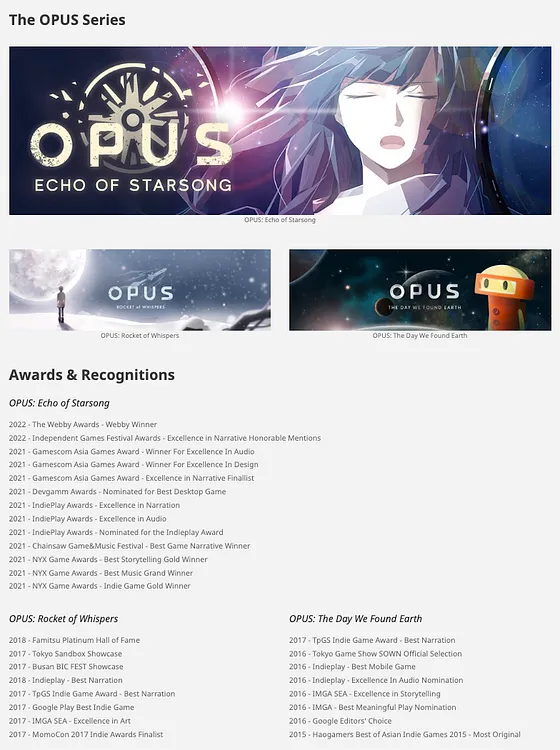
caption: Supplementary materials to support journalists in creating comprehensive and engaging reports
By now, you should have a solid understanding of how to effectively help journalists create compelling stories! While there are many intricate details, the core principle remains:
You must drive traffic to the media.
Think from their perspective, and communicate in their language.
If you have a quality product and have evaluated your team’s return on investment, try these methods and share your successful strategies with me!
About OPUS: Prism Peak
OPUS: Prism Peak is a narrative adventure where your choices lead to divergent endings. Play as a photographer lost in an ethereal realm, and unveil its mysteries with your camera to find a way home.
If you’re interested, you can check it out here:
https://store.steampowered.com/app/1947910/OPUS_Prism_Peak/
This article was originally published at https://medium.com/@sigono?p=1d9d8a7b256b






